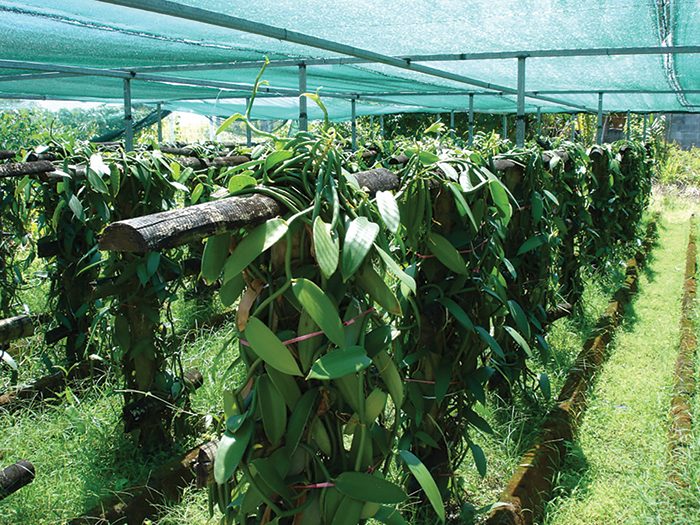Say Goodbye to Chocolate: Climate Change Is Destabilizing the Food Supply Chain

Some foods and flavors are such a ubiquitous part of our culture that it’s difficult to envision life without them. Just try to imagine the ice cream aisle at your supermarket without vanilla or chocolate.
For you ice cream lovers, that’s an unnerving thought. But for ice cream manufacturers — and for all of the companies that make the tens of thousands of products that include natural vanilla or chocolate flavoring — that’s a nightmare.
It’s one brand of risk management to prepare your company for a sudden, temporary shortage of key materials caused by a natural disaster. It’s quite another to consider a long-term or even permanent absence of an essential ingredient or part.
Climate change is increasing that risk for a variety of agricultural products. Changing temperature and precipitation patterns and volatile weather event exposures are turning once-arable land into inhospitable environments for certain tender crops. The list of those under known threat includes such core staples as coffee, avocados, wine grapes, chickpeas, peanuts and — sadly — chocolate and vanilla.
The Not-So-Sweet Tale of Vanilla
The current plight of vanilla beans illustrates what food manufacturers are facing. At least 18,000 products globally contain vanilla flavor. But only 1 percent of the total global market for vanilla flavor is actually sourced from vanilla beans.
That 1 percent is highly coveted, and Madagascar holds 80 percent of the global supply.
In 2017, tropical cyclone Enawo, the strongest to strike Madagascar in 13 years, left 22,000 people homeless and devastated the region. The region’s output of vanilla beans plummeted to 1,100 metric tons, barely two-thirds the normal harvest.
In perspective, the dairy industry typically uses half of the total imported vanilla to North America. Ice cream manufacturers generally use pure vanilla to avoid having to use “vanilla flavored” or “artificial vanilla” on their labels.
Synthetic vanilla flavoring — vanillin — is widely available and has been for decades. But at least 85 percent of the 18,000 metric tons of vanillin produced annually is derived from a petroleum byproduct, making it less desirable as customer demand for all-natural products grows.
Say goodbye to chocolate: Climate change and volatile weather events are turning once-arable land into inhospitable environments for a number of crops.
That’s exactly why Enawo’s timing couldn’t have been worse. Nestlé, Unilever and General Foods just announced that they would eliminate artificial ingredients — including artificial vanilla — from their products.
The confluence of rising demand and diminished supply impacted prices drastically. A kilogram of vanilla beans, valued at about $40 in 2011, currently tops $600, making it the second most expensive spice in the world after saffron.
Some are working to fill the gap. International Flavors and Fragrances is working with a company called Evolva to develop and market a yeast-based fermentation route to both vanillin and other vanilla flavor components.
But even with successful attempts at developing alternative sources of vanillin, food makers face reformulation challenges, complicated labeling laws, and difficult questions about what is “natural.”
Volatility and Agriculture Don’t Mix
While crop yields could indeed rebound, the risks of future crop damage are high as climate patterns shift. Madagascar has the highest risk from cyclones in Africa. In the past 20 years, the country has been struck by 35 cyclones, eight floods and five periods of severe drought.
Cacao crops are similarly endangered. They can only grow within a narrow strip of rainforest around 20 degrees north and south of the equator, where temperature, rain and humidity stay relatively constant year-round. More than half of the world’s chocolate comes from Côte d’Ivoire and Ghana. But by 2050, those areas won’t be suitable for growing cacao. Rising temperatures will push today’s chocolate-growing regions more than 1,000 feet uphill into mountainous terrain that is currently preserved for wildlife.
The coffee industry faces similar challenges, with farmers having to work at higher elevation due to changing temperature and precipitation. But as farms move up mountain, the costs for managing those farm goes up.
Said the director of supply chain for a Fortune 1000 food manufacturer, “There are things that we know: weather patterns are shifting, places are getting hotter, it rains where it shouldn’t and doesn’t rain where it should. We know all of that, there are these external weather events that even for us [are impossible to foresee]. Global warming may still be a very controversial topic, but we see on a day-to-day basis how it’s affecting us.”
Faced with levels of long-term supply uncertainty on this scale — including the real risk of some crops becoming extinct or too rare to be viable commodities — what’s a food manufacturer to do?
Catastrophe-related crop damage is insurable, but the creeping devastation of climate change, not so much.
“You’re talking about permanent loss of potential yield, as in this is just not coming back — that’s something that an insurance market wouldn’t be particularly good at dealing with it,” said Greg Lowe, global head of Resilience and Sustainability at Aon.
“Maybe the closest analogy from a natural peril perspective would be sea-level rise. You’re not talking about a temporal event like a flood or an earthquake, you’re talking about a change in the permanent state of the coastline.
“If we were to see some kind of mechanism that would lead to particular crops not being viable in parts of the world, that’s an exit from the world commodity markets. You’re not going to have an insurance solution to back that up.”
Agricultural shifts related to climate change present more of a risk management challenge than an insurance one, and there are numerous approaches procurement and risk management teams can take to maintain their supply chains.
Stockpiling is certainly an option in some cases — buying up every ounce of the product you can get your hands on. That can at least buy some time while the company tries to gather more intelligence and plan next steps. But shelf life has to be factored in, as does the cost of keeping a high level of inventory. And in the end, of course, it’s just a stop-gap measure.
All possibilities would have to be considered, said the supply chain director, including whether sufficient supply might be available from alternative suppliers or regions. In a market where supplies are scarce, however, it will be the companies with the most leverage that are able to secure the lion’s share of the sources, while small to mid-sized producers are left scrambling.
“The relationship is always predicated on the economics,” said Gary Lynch, founder of The Risk Project, a risk analytics based advisory firm.
“At the end of the day, you can be with a supplier for 20 years. But the reality is that if, from an economic standpoint it [ceases to be] beneficial to both parties, then it goes away.”
The problem of “citrus greening” in Florida’s orchards is a clear example, said Cracknell, partner and head of the consulting risk practice at JLT in the UK.
“You’re talking about permanent loss of potential yield, as in this is just not coming back — that’s something that an insurance market wouldn’t be particularly good at dealing with it,” — Greg Lowe, global head of Resilience and Sustainability, Aon
“If you’re a [smaller] local company producing orange juice or lemon juice and you suddenly find that the sources that you would ordinarily go to have got this disease and [supply has] shrunk, you end up on the commodities markets looking to buy orange juice from wherever you can get it. You may end up importing it, and there are much more significant costs attached to that. You either have to take the hits or increase your prices, which probably makes you uncompetitive — it could be a make or break.”
If supply is unsustainable, “it will really go down to what is viable,” said the supply chain director.
“[It might be using] a close substitute because when there’s a crisis, people don’t need a 100 percent match. If it’s close enough, they’re happy. We’ll try to maintain our supply even if it’s not exactly the same. It’s better than not having anything to sell.”
That said, substitutions have to be carefully considered because they carry risks of their own, said Caitlin McGrath, vice president, National Product Recall and Accidental Contamination Risk Consulting, Lockton.
“You’re changing what’s going on in your facility and its risk profile,” she said, citing an example of a company substituting fruit juice for honey as a sweetener.
“Companies need to think about, as you try to replace those products, how that’s going to affect your business and how you need to protect yourself, whether it’s a matter of risk transfer or just preparing your facility and making sure you have the right equipment, the right training, etc.”
In some cases, said the food manufacturing executive, manufacturers will take a more proactive approach to a failing supply chain, asking “Is this something we need to be part of?”
“Sometimes it will trigger a discussion around are we going to acquire something, are we going to invest in something, is it important enough that we really need to find a way to participate in the downstream supply chain? … How much more influence can we have on encouraging supply?”
A Florida food manufacturing client of Tim Cracknell’s applied that strategy to citrus greening, which posed an existential threat to its business. The company didn’t just switch sourcing to Brazil, it purchased its own orchards there across a wide region to minimize the risk of the impact of greening arising to their entire crop.
“So they’ve got an absolute guarantee that whatever those orchards produce [belongs to them]. That’s where some companies go that one step further,” said Cracknell, partner and head of the consulting risk practice at JLT in the UK.
An increasing number of manufacturers are thinking proactively, engaging with the supply chain at different levels to help support smallholder farms and ensure the ongoing viability of the crops they depend on to sustain their brands.
Numerous global food manufacturers, for instance, are working with orchid growers in Madagascar to ensure the future of sustainable, high-quality vanilla production.
Nestlé’s Nespresso provides a prime example of that strategy in action, said the supply chain director. The company found itself unable to source enough of the premium grade of coffee it had built its brand on — demand outstripped its ability to source.
“They decide to go there, work with the farmers, and work with [non-governmental organizations] to see how to encourage them to grow those premium beans,” she said. “It’s becoming a fairly common strategy food companies use to secure future supply.”
Other forward-looking efforts to secure supply are trending toward high-tech. Chocolate-maker Mars is working with UC Berkeley to develop cacao plants that don’t wilt or rot at their current elevations, eliminating the need to relocate farms.
The project is being overseen by Jennifer Doudna, the geneticist who invented the gene-editing tool CRISPR. If successful, the project holds a great deal of promise for other crops that currently only thrive within narrow growing parameters.
Elevate the Conversation
With the nature of food manufacturing supply chain risk changing rapidly, it’s important to break down silos, said experts. Risk management hasn’t traditionally been a part of the decision-making process for sourcing or product development for many companies, but it’s time for that to change, for the food industry as well as for all manufacturing sectors.
“My sense is that risk managers aren’t probably involved as much as they should be,” said Lowe. “[This is] systemic, [this is] longer-term.”
Using risk management principles can help companies adopt a market mindset as opposed to an operational mindset, said Gary Lynch, CEO of The Risk Project.
“That really starts to engage leaders in helping to understand [the challenges and opportunities] in the market.”
That means opening discussions around whether the problem can be engineered around, whether the product line might need to sunset, whether to invest in securing future capacity by acquiring some of the sources, said Lynch, “or, like Nestlé did, sending people out to Madagascar to basically recreate the supply chain to make it more stable and prepare for the future.”
Those are enterprise-level discussions, agreed experts, which should include all functions from risk management to procurement to finance to sustainability all the way to R&D.
“I would definitely suggest the risk manager needs to be part of the R&D process for the next-generation products,” said JLT’s Cracknell. Particularly as manufacturers more deeply engage and influence the supply chain, it only makes sense to engage the risk management perspective on potential loss exposures and whether adequate coverage is in place for non-traditional ventures such as genetic editing of plants.
“From that perspective, you’re creating a new, exciting world. But it’s also a world that looks very different from the traditional types of challenges that risk managers have faced,” said Lowe.
“Our food chain, our supply chain our just-in-time manufacturing approach doesn’t lead us to allow a lot of room for error,” said Phil Renaud, Executive Director at the Risk Institute at the Ohio State University Fisher College of Business.
“So, if you don’t have the resilience approach to business then you will lose most likely market share. [Customers] will go elsewhere and it won’t take very long for that to happen.”
“Risk management needs to be everyone’s responsibility in an organization,” he said.
“It isn’t just that team of one, two or 22, depending upon the size of the business. It needs to be everyone thinking about risk. Everyone needs to have a vested interest.” &












